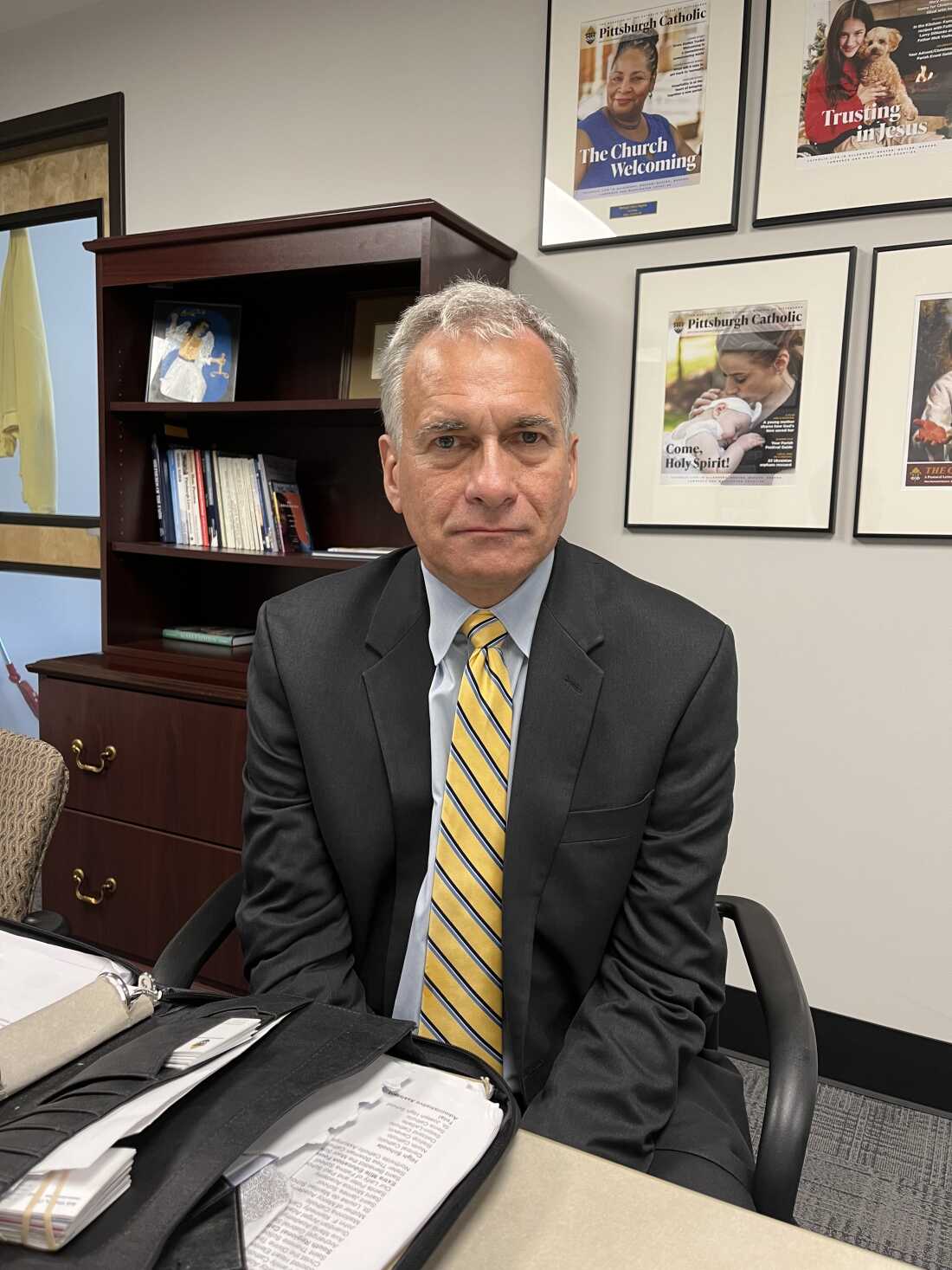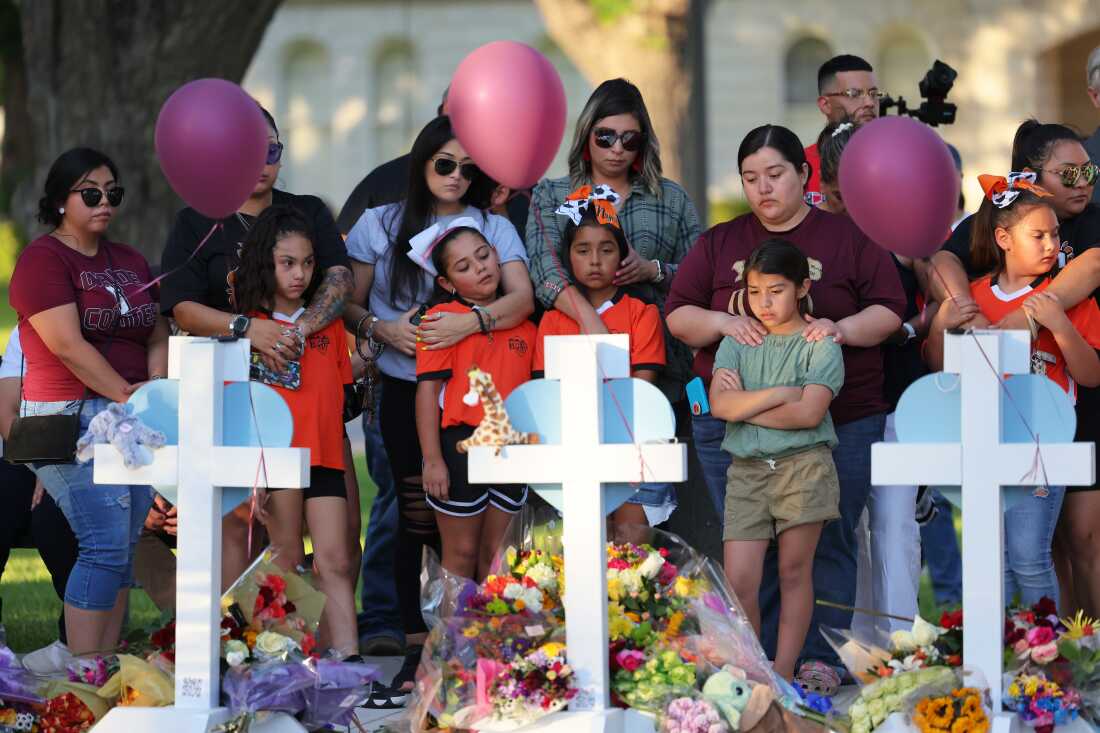
[ad_1]

Police preserve a presence following a faculty lockdown after 911 calls falsely reported a gunman in Oakland Catholic and Pittsburgh Central Catholic colleges on March 29, 2023.
Jeff Swensen/Getty Photos
conceal caption
toggle caption
Jeff Swensen/Getty Photos
The dangers of gun violence in colleges had been made tragically clear once more in Georgia, the place a young person stands accused of taking pictures his approach by way of his highschool and killing two college students and two academics.
In Pittsburgh in March 2023, it was a false alarm {that a} gunman was roaming one Catholic highschool after which one other that touched off scary evacuations and a strong police response within the metropolis. It additionally prompted the diocese to rethink what constitutes a mannequin studying surroundings.
So months after SWAT groups met lots of of scholars, the Catholic Diocese of Pittsburgh started forming its personal armed police pressure.
Wendell Hissrich, a former security director for town and profession FBI unit chief, was employed that 12 months to kind a division to safeguard 39 Catholic colleges in addition to dozens of church buildings within the area. Hissrich has since added 15 officers and 4 supervisors, together with many previously retired officers and state troopers, who now oversee college campuses fitted with Cease the Bleed kits, cameras, and defibrillators.

Wendell Hissrich, a former profession FBI unit chief, was employed by the Catholic Diocese of Pittsburgh in 2023 to assist thwart gun violence in colleges. He has since employed many retired officers and state troopers, who oversee college campuses fitted with Cease the Bleed kits, cameras, and defibrillators.
Christine Spolar for KFF Well being
conceal caption
toggle caption
Christine Spolar for KFF Well being
When non secular leaders first requested for recommendation after what are often called “swatting” incidents occurred, the veteran lawman mentioned he didn’t hesitate to ship blunt recommendation: “You want to put armed officers within the colleges.”
However he added that the officers needed to view colleges as a particular task: “I need them to be function fashions. I need them to be good matches inside the college. I’m searching for somebody to know tips on how to cope with children and with mother and father — and, most significantly, is aware of tips on how to de-escalate a scenario.”
Gun violence is a number one reason behind dying for younger folks in America, and the potential of shootings has influenced expensive decision-making in class techniques as directors juggle concern, responsibility, and dizzying statistics in efforts to maintain colleges secure from gun hurt.
Nonetheless, scant analysis helps the creation of college police forces to discourage gun violence — and what knowledge exists can increase as many questions as solutions. Information exhibits over half of U.S. firearm deaths are, the truth is, suicides — a sobering statistic from the federal Facilities for Illness Management and Prevention that displays a variety of ills.
Gun violence grew through the COVID-19 pandemic and research discovered that Black kids had been 100 occasions as doubtless as white kids to expertise firearm assaults.
Analysis on racial bias in policing general within the U.S. in addition to research on biased college self-discipline have prompted requires warning. And an oft-cited U.S. Secret Service assessment of 67 thwarted plots at colleges helps causes to look at parental duty in addition to police intervention as efficient methods to cease firearm hurt.
The Secret Service risk evaluation, printed in 2021, analyzed plots from 2006 to 2018 and located college students who deliberate college violence had weapons readily at residence. It additionally discovered that college districts that contracted sworn legislation officers, who work as full or half time college useful resource officers, had some benefit. The officers proved pivotal in a few third of the 67 foiled plots by present or former college students.
“Most colleges aren’t going to face a mass taking pictures. Despite the fact that there are extra of them — and that’s horrible — it’s nonetheless a small quantity,” mentioned Mo Canady, government director of the Nationwide Affiliation of College Useful resource Officers. “However directors can’t actually enable themselves to assume that approach. They must assume, ‘It might occur right here, and the way do I forestall it.'”

A scholar from Oakland Catholic Excessive College receives consolation following the evacuation of the college after a name of an lively shooter on March 29, 2023 in Pittsburgh, Pennsylvania. Many colleges, together with Oakland Catholic and Pittsburgh Central Catholic, had been focused as a part of what authorities are calling “computer-generated swatting calls.” Many businesses, together with state and municipal police, are conducting investigations.
Jeff Swensen/Getty Photos
conceal caption
toggle caption
Jeff Swensen/Getty Photos
$1 million to station police in colleges
A couple of 20-minute drive north of Pittsburgh, a prime public college system within the area determined the chance was too nice. North Allegheny Superintendent Brendan Hyland final 12 months beneficial retooling what had been a two-person college useful resource officer group — staffed since 2018 by native police — right into a 13-person inner division with officers stationed at every of the district’s 12 buildings.
A number of college district board members voiced unease about armed officers within the hallways. “I want we weren’t within the place in our nation the place we’ve got to even take into account an armed police division,” board member Leslie Britton Dozier, a lawyer and a mom, mentioned throughout a public planning assembly.
Inside weeks, all voted for Hyland’s request, estimated to price $1 million a 12 months.
Hyland mentioned the intention is to assist 1,200 workers members and eight,500 college students “with the fitting people who find themselves the fitting match to enter these buildings.” He oversaw the launch of a police unit in a smaller college district, simply east of Pittsburgh, in 2018.
Hyland mentioned North Allegheny had not targeted on any single information report or risk in its choice, however he and others had thought by way of tips on how to set a typical of vigilance. North Allegheny doesn’t have or need steel detectors, units that some districts have seen as vital. However a educated police unit keen to be taught each entrance, stairway, and cafeteria and who might develop belief amongst college students and staffers appeared cheap, he mentioned.
“I’m not Edison. I’m not inventing one thing,” Hyland mentioned. “We don’t need to be the district that must be reactive. I don’t need to be that man who’s requested: ‘Why did you enable this to occur?’”

Folks go to memorials for victims of a mass taking pictures at Robb Elementary College in Uvalde, Texas. Nineteen kids and two adults had been killed after a person entered the college by way of an unlocked door and barricaded himself in a classroom the place the victims had been positioned. Legislation enforcement officers waited within the hallway for over an hour earlier than coming into the classroom and confronting the gunman.
Michael M. Santiago/Getty Photos/Getty Photos North America
conceal caption
toggle caption
Michael M. Santiago/Getty Photos/Getty Photos North America
A tragic failure in Uvalde
Since 2020, the function of police in academic settings has been hotly debated. The video-recorded dying of George Floyd, a Black man in Minneapolis who was murdered by a white police officer throughout an arrest, prompted nationwide outrage and demonstrations in opposition to police brutality and racial bias.
Some college districts, notably in giant cities corresponding to Los Angeles and Washington, D.C., reacted to issues by lowering or eradicating their college useful resource officers. Examples of unfair or biased therapy by college useful resource officers drove among the choices. This 12 months, nonetheless, there was obvious rethinking of the dangers in and close to college property and, in some cases in California, Colorado, and Virginia, mother and father are calling for a return of officers.
The 1999 bombing plot and taking pictures assault of Columbine Excessive College and a bloodbath in 2012 at Sandy Hook Elementary College are sometimes raised by college and police officers as causes to organize for the worst. However the worth of getting police in colleges additionally got here beneath sharp assessment after a blistering federal assessment of the mass taking pictures in 2022 at Robb Elementary College in Uvalde, Texas.
The federal Division of Justice this 12 months produced a 600-page report that laid out a number of failures by the college police chief, together with his try to attempt to negotiate with the killer, who had already shot right into a classroom, and ready for his officers to seek for keys to unlock the rooms. In addition to the teenage shooter, 19 kids and two academics died. Seventeen different folks had been injured.
The DOJ report was primarily based on lots of of interviews and a assessment of 14,000 items of knowledge and documentation. This summer time, the previous chief was indicted by a grand jury for his function in “abandoning and endangering” survivors and for failing to establish an lively shooter assault. One other college police officer was charged for his function in inserting the murdered college students in “imminent hazard” of dying.
Pursuing accountability for gun violence
There have additionally been elevated judicial efforts to pursue enforcement of firearm storage legal guidelines and to carry accountable adults who personal firearms utilized by their kids in shootings. For the primary time this 12 months, the mother and father of a young person in Michigan who fatally shot 4 college students in 2021 had been convicted of involuntary manslaughter for not securing a newly bought gun at residence.
In current days, Colin Grey, the daddy of the teenage taking pictures suspect at Apalachee Excessive College in Georgia, was charged with second-degree homicide — essentially the most extreme costs but in opposition to a mother or father whose little one had entry to firearms at residence. The 14-year-old, Colt Grey, who was apprehended by college useful resource officers on the scene, in line with preliminary media stories, additionally faces homicide costs.
Hissrich, the Pittsburgh diocese’s security and safety director, mentioned he and his metropolis have a hard-earned appreciation for the apply and preparation wanted to include, if not thwart, gun violence. In January 2018, Hissrich, then town’s security officer, met with Jewish teams to think about a deliberate method to safeguarding amenities. Officers cooperated and had been educated on lockdown and rescue workout routines, he mentioned.
Ten months later, on Oct. 27, 2018, a lone gunman entered the Tree of Life synagogue and inside minutes killed 11 individuals who had been making ready for morning examine and prayer. Legislation enforcement deployed shortly, trapping and capturing the shooter and rescuing others caught inside. The coordinated response was praised by witnesses on the trial the place the killer was convicted in 2023 on federal costs and sentenced to die for the worst antisemitic assault in U.S. historical past.
“I knew what had been finished for the Jewish group so far as security coaching and what the officers knew. Officers practiced months earlier than,” Hissrich mentioned. He believes colleges want the identical type of plans and precautions. “To place officers within the college with out coaching,” he mentioned, “could be a mistake.”
KFF Well being Information is a nationwide newsroom that produces in-depth journalism about well being points and is likely one of the core working applications at KFF — the impartial supply for well being coverage analysis, polling, and journalism.
[ad_2]

